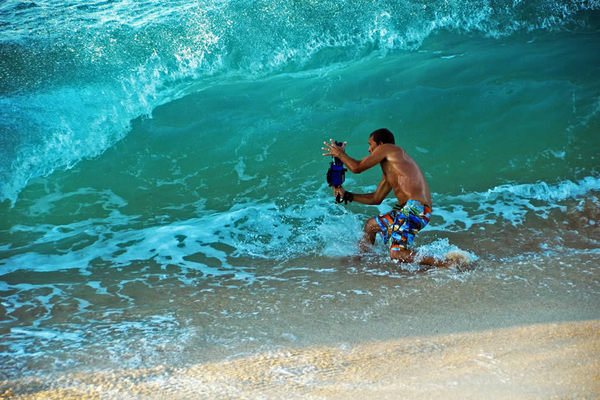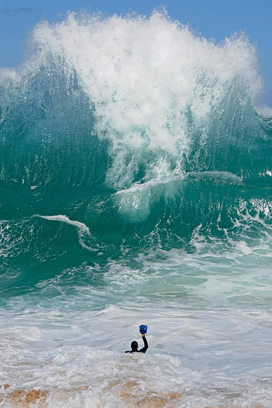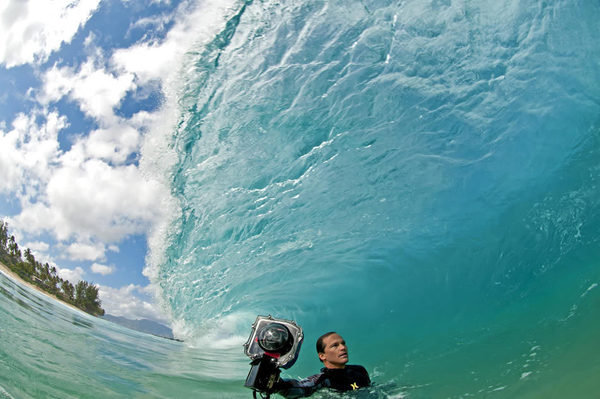THE HOURGLASS
Inside Peek:
Whisper Talks With Clark Little
July 13, 2014
Judith Puckett-Rinella of Whisper Editions and world renowned wave photographer Clark Little dive in tête-à-tête for this week’s inside peek.
Judith Puckett-Rinella: You have and continue to create something very special with your photographs that gets people extremely excited about not only your work, but the ocean and photography simultaneously. When I first saw your work- there was clearly this very visceral reaction that I had- if I could watch a video of myself seeing your work for the first time I am sure my eyes widened and my mouth dropped open- and if I recall I said some sort of positive expletive out loud even though no one was around. Is this a reaction that you are trying to evoke out of your viewers- this WOW factor? Do you consciously go out in the water with the end result in mind?
Clark Little: I don’t go out in the water with the end result in mind. It really is for myself why I am out there. I feel so good after being in the water, shooting, ducking under waves, breathing hard. It’s a workout, just like surfing, running or doing other sports. And being out in the surf in Hawaii is usually a big “Wow” in itself. As long as you don’t become jaded or spoiled. If you have appreciation and can really stop and look at the waves and ocean, it is really a cool thing that mother nature serves up.
I look at the conditions and check in with myself to see if it is something I want. When it is really big, I got to be into it. Almost always I am. Even when it is small, I will go out because it looks like fun. I feel the need to clear my slate and get a salt water refresh. As long as I am having fun, I will then stay out for a while. Sometimes it is in those additional minutes, “ahhh I’ll just stay out for a few more waves” is when the sky clears, the wind dies and the gems come. It is a lesson not to judge a day by how it initially looks since things are in constant motion.
One thing I will say, is when I am selecting my images after a photo shoot, usually I will shoot 300, 400 or more in a session, that is when I do think of the WOW factor and the viewer. I want something that grabs my attention and in turn will interest others too. At this point, my work is shared with a lot of people, so I am conscious trying to show something that is fresh.
JPR: Now that I have seen your wave photographs- there is really nothing else that compares that's out there currently. You really found a way to communicate the power, beauty, and strength that these waves have at the shore break in the way no one else has been able to do. There are people, both enthusiasts and professionals, that are trying to shoot the way that you do- what are your thoughts and feelings about the genre of photography that you have created and about people essentially mimicking what you do?
CL: I admit, at first I was a bit protective and felt bummed when I saw people doing the exact same thing. Especially the crowds of other photographers. When I started I was basically the only one out shooting the shorebreak. I hardly saw anyone else. So when the crowds started coming, it did surprise me.
By now, I have embraced the situation. How can you not? The whole thing really took off and a lot of people got exposed to it. I have so much fun shooting. I can understand why others would also want to try it and experience the same great feeling that I get. There are so many good things that come from trying this out. Kids and adults can learn about photography, get off the couch and get in the water, get a great workout, build up ocean awareness and some people are also selling their wave artwork and learning about business. It all seems very positive to me.
JPR: I live in New York City- so when I look at your work it feels so far away from my day to day reality which is very alluring. I imagine that most people who have 9-5 desk jobs and sit looking at a computer screen all day are very drawn to your work for the simple pleasure of imagining a different day to day reality. Can you share with us what it is like to work in YOUR office each day? How much time do you spend in the actual waves vs the time spent editing and preparing your work for exhibitions? Have you ever had a desk job?
CL: Since I take a lot of shots each time I go shooting, 300 and up per session, I have to spend as much time going through them when I get back to my studio. Images also have to be processed out of the raw formats. It can be a lot of time. I love shooting the photos, but sitting in front of my computer is sometimes my least favorite part. Of course, I love to see them for the first time on a large screen. But I need to be in the right mood and space to sit for hours at a time.
During the winter when the waves are big on the North Shore, I will go shooting 5 or more days a week on the good weeks. Sometimes I will go out twice in one day. A session is usually at least an hour or two. If the conditions are really good, I will stay out until my battery dies on my camera or until my memory card is full. Sometimes this means 4-5 hours. I get out blue and shivering, starving and sunburned. During the winter I can easily lose 25 or more pounds just by the sheer work out.
Of course, there is also the business aspect of what I do which does take up time. But the business is what keeps the engine running, so it is a priority to spend the necessary time at it.
I was a manager at a botanical garden here in Hawaii for 17 years. Once my photography took off, I resigned. It was a desk and also outdoor job. I do know what it is like to have a 9-5 job.
JPR: Do you still find time to surf?
CL: I only surf a few times a year now. Just with my kids when we are at the beach. I love surfing and follow it but the biggest love for the last 6-7 years has been photographing waves. The camera is now my surfboard. I get the same “stoke” that I got when I went surfing as I do when I am shooting waves. Its funny, because when I am out surfing those few times each year, I am looking around at the waves and wishing I had my camera. I feel like I am missing something and can’t stand it.
JPR: Can you talk a little about your custom camera equipment- how is water-resistant and how can it with stand those constant poundings from the waves? Do you feel that your camera becomes an extension of yourself when you are out there in the water- like the surf board used be?
CL: The waterhousing I used these days are made by AquaTech. They are lightweight and durable sport housings built with a Polyurethane construction with stainless steel and aluminum for the controls and clips. It basically acts as a tank that encases a professional camera.
There is an interchangeable port system for a range of lenses. I like to use a “pistol grip” which means I am gripping it in one hand. There is a “trigger” button for my index finger that I can push and it is connected to my shutter. https://aquatech.net
These housings are used in advertising, surfing, sailing, documentary, fashion, fishing, Olympic water sports and more. They can take a pounding. So can my Nikon camera that sits in these housings. I have almost never had a problem with a camera breaking in over 7 years of shooting.
One of my most important tools isn’t necessarily a piece of camera equipment, but are my Ally swim fins. I actually have my own model of swim fins! These are my lifesaver and allow me to swim quickly into waves or to avoid them. And when the ocean conditions are extreme and the wave are huge, these help me get back to shore and allow me to fight the strong rip currents and not sucked out to sea.
JPR: Have you ever been injured shooting?
CL: Nothing too seriously, but I have had some. I separated my shoulder a few years ago when I got picked up by a wave and dumped shoulder first into the dry sand. There was a loud crunch and it hurt pretty bad. But I was out again a few week later. I have also had a few whacks with the camera housing to the head. Nice gouges with some blood coming down. A few close calls with being out of breath and held under by multiple waves. When it is really big, there is no time to come up for air when you are being tossed around underwater. Multiple wave hold downs start to test the limits. Things start to get pretty fuzzy and I think of my family and how I might not see them again.
JPR: What is ultimately the most satisfying aspect to what you do?
CL: Being able to share the beauty of the ocean, especially the shorebreak waves with everyone.
When I used to go surfing I would look at the waves while surfing and then try and explain what I saw to my family and friends. Some got it, but those that don’t surf, would never really understand. It is very hard to describe a beautiful moving wave with words. But with photography, I feel people really get it. They can see the beauty in it, and appreciate it. Especially since these shots are coming from a place they will most likely never be able to be at.
And then to see that sharing these waves with people is allowing me to continue to do my photography, its a great situation.
JPR: What can we expect from Clark Little next?
CL: I really don’t know what’s coming up next. Things are real fluid these days I can’t predict what will happen next. It’s actually exciting not to know.
For example, I had no idea that just this last week, a video on my photography would go viral with 4 million plus views on YouTube ( http://youtu.be/9pXMObfeOcE ) and my Instagram followers would surpass a million. I had an extra 100,000 people join just this last week. It turned out to be quite a week and I didn’t see it coming at all.
What I do have in my schedule in the next few weeks... There is an outdoor solo show opening in July in Montreal with 12 big pieces lining the Montreal Harbor. The show will be up for a year. I also have a solo show in Shibuya, Tokyo at a super hip gallery in Shibuya called Parco. The same week there is the release of my first book in Japanese which is put out by Parco Publishing. I will fly over there for 48 hours to be at the exhibit opening, two days of book signings and press rounds.


